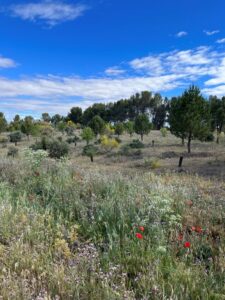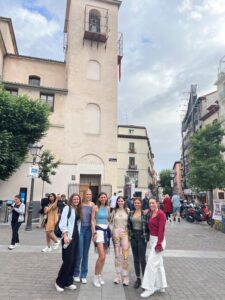Meet the Global Office Intern: Emma
My name is Emma, I’m a fourth-year student studying Medieval History and Spanish, and I’m the Global Office intern. In my third year, as part of the Spanish side of my degree, I went to the Universidad de Alcalá on a semester abroad.
There were lots of similarities between Alcalá and St Andrews, the first being that both are small towns. St Andrews famously has three key streets, and Alcalá pretty much has just one long street, Calle Mayor (its name literally translating to ‘biggest street’) but it was always bustling with people, albeit walking very slowly, as you will know if you have ever been to Spain. Despite being small, however, as St Andrews is well-connected to Edinburgh, so is Alcalá to Madrid. Just 40 minutes by train, it is a smooth and pleasant journey, as long as you’re happy to listen to buskers who range in quality as well as style, from singers to bands of ukelele players. Alcalá’s proximity to Madrid meant that I went often, whether to visit museums, try out language exchanges, or try cafes I had seen on my Instagram for you page.

Also similar to St Andrews were the unique traditions Alcalá had to offer. If you’ve ever been in St Andrews around the time of the Kate Kennedy procession, you will probably recall feeling somewhat bewildered. This is exactly how I felt on my first day in Alcalá when I saw a priest on a stool blessing a dog. Of course, it was the blessing of the domestic animals. This, alongside the historical fair to celebrate Cervantes (born in Alcalá in 1547), the literary festival in Spring, and many more events, meant there was always something to see, even if you weren’t quite sure what it was.

In terms of studying at Alcalá, it was hard but also enjoyable. A few of us from St Andrews found we had to change our original module selection on arrival due to timetabling issues, but we did have help from the host learning coordinator to find suitable second choices. The classes I ended up taking were challenging; one in particular was the History of the Spanish Monarchy, which required a hefty amount of reading each week. In this class, my tutor also loved to call on me to ask me questions. It was lovely that he was including me, but embarrassing in that he would ask a question about who was ruling England in specific year and I, despite being a history student, responded more often than not with “No lo sé”. The one time I did attempt an answer I later looked it up to find out I was wrong, but I’d said it with enough confidence in class that he had accepted my answer and moved on.
The teaching style is different from St Andrews, in that answering essay questions is more to do with learning arguments of academics and reciting these, rather than analysing the arguments. This took me a while to get used to, but don’t get me wrong, when I’m learning in Spanish, I’d rather memorise an argument about Philip IV’s foreign policy than try to analyse it!
My tutors were reachable by email or at the end of classes, and I also found one or two students willing to help when I had asked the tutor and still had no idea what was going on (part of this was my Spanish ability, but I’m sure part of it was just my lack of common sense). It’s also worth saying that the classes were really interesting. Learning about Spanish history in a Spanish context brought up questions in the classroom which were closely tied to identity and what it means to call someone ‘Spanish’, given that the country has not always been unified, and different regions remain committed to their autonomy.

Academics aside, in my spare time I made the most of what Alcalá and Madrid had to offer. Alcalá had great hiking routes which I did on the weekends with friends. It also had great pastelerías which I would frequent during study breaks in the library (my coffee order was fluent by the end). In Madrid I often found myself in El Retiro park, to walk, relax or enjoy a picnic. I visited the Prado Museum a few times for free with my student card, and I loved walking down the streets and popping into independent shops. This I did even more when my family came to visit, and I became the tour guide, but imagine a tour guide who doesn’t speak the language fluently and also doesn’t have an exact geographical knowledge of the area, so ends up taking you on longer routes (I subjected my parents to 34,000 steps in one day and we were all hobbling by the end). I also travelled on the weekends to towns nearby Alcalá, such as Aranjuez and Toledo, the latter of which is an absolute must-see. Over Easter, with the help of my Stevenson scholarship, I was able to travel to Granada with a friend and visit the Alhambra and the Royal Chapel of Granada. These things had been on my bucket list for a long time, so it was very special to tick them off.

Overall, I feel that I learned a lot on my time abroad; I gained practical skills such as organising travel cards and accommodation, but I also felt my confidence increase as I made friends, gave class presentations, and travelled. Doubt, nerves and feeling generally overwhelmed were all very much feelings I had at various points in the semester, but I do reflect now and feel proud that not only did I manage to do a semester abroad, but I managed to do it in Spanish! And so, if you’re on the fence about going abroad, I would tell you to jump off the fence and jump onto a plane (with as much hand luggage as possible to avoid the fee for a suitcase which exceeds the weight limit. I speak from experience). The year abroad is a great opportunity to learn and try new things and immerse yourself in a different culture; have faith in yourself and remember you can do it!
